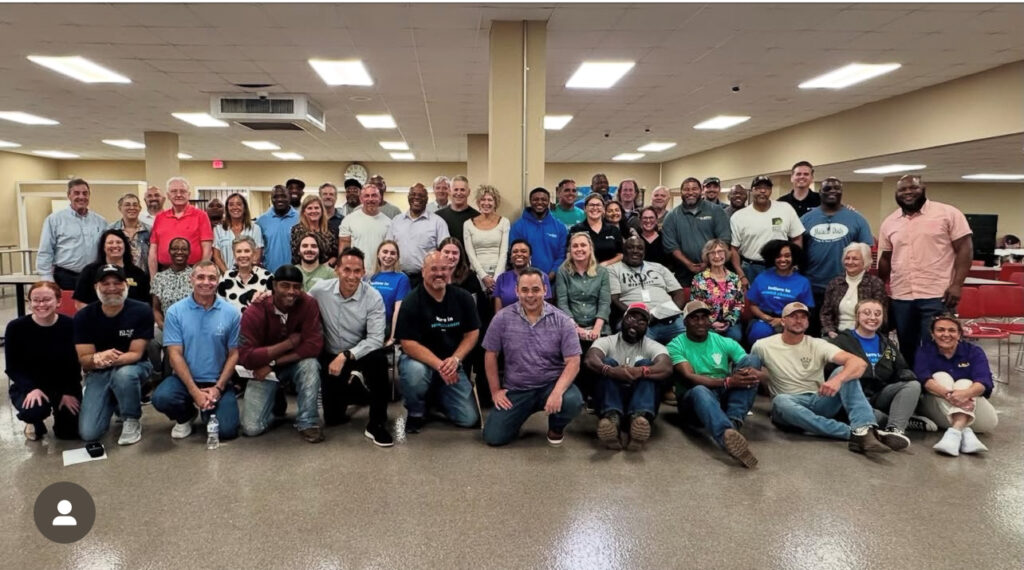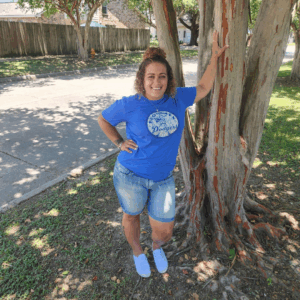The duality of incarceration is as striking as the stigma that surrounds it.
There’s hopefulness in the hopelessness, joy in the pain, and light in the darkness. Visiting a prison curates a shared experience where two people – who would never meet otherwise – can sit shoulder to shoulder and find commonalities in their lives.
At the end of May, a group of 33 visitors from across the country traveled to the Louisiana State Penitentiary, commonly known as Angola, and the next day, 28 visitors traveled to Dixon Correctional Institute in Jackson, Louisiana, through a partnership between Parole Project and the Frederick Douglass Project for Justice.
The Frederick Douglass Project is a Washington, D.C.-based nonprofit that facilitates structured meetings and respectful conversations between members of free society and incarcerated people. It currently operates in 25 prisons across 17 states, including two in Louisiana (Elayn Hunt Correctional Center and the Louisiana Correctional Institute for Women). This was the first time Angola and Dixon hosted a Douglass visit.
Dixon Warden Dusty Bickham welcomed the group to Dixon and led them on a three-hour tour through the prison, highlighting the infirmary, the dog shelter and the vo-tech building.
“The main goal and issue here is public safety,” Bickham said. “If we have programs that work, let’s use them.”
Marc Howard founded the Frederick Douglass Project after visiting his childhood best friend in prison who had been wrongfully convicted of murdering his parents. Those visits reshaped Howard’s life and transformed his career. A professor of government and law, he became a lawyer to help his friend who was, eventually, exonerated. Howard is now a criminal justice reform leader and he said bringing the Douglass Project to Angola has been a goal from the start.
“This is a historic day, and one I have dreamed of for a long time,” Howard said. “The origin of this program was my eyes in a visiting room and my heart feeling something different. My life changed in that visiting room. I saw humanity, joy, tears, laughter. Everywhere I go I see human beings.”
This is the story of Angola.
“This has been an eye-opening experience,” said Dwight Hudson, East Baton Rouge metro councilman for district 9. “The first thing I recognized was a sense of safety. You see this on TV, and you think it’s going to be scary. It’s not as scary a place as you would think.”
A quick google search of Angola will fill a computer screen with scary images and language. The former plantation turned prison in the early 1900s with a violent history is 18,000 acres and the largest maximum-security prison in the country.
It is about an hour-long drive from Baton Rouge and a two hour and 15 minute-drive from New Orleans. The last 20 miles of the trip are on Tunica Trace or La. Hwy 66, a windy road with limited cell service. While the arching sign across the gates of the prison reads “Louisiana State Penitentiary,” it’s historically known as Angola because of the plantation by the same name that occupied the land. It’s roughly the size of Manhattan, Assistant Warden Anne-Marie Easley explains.
Bordered on three sides by the Mississippi River and on one side by Tunica Hills, there are 4,400 men incarcerated at Angola and most live in dormitory-style housing. Each camp functions independently and is named after a bird, animal or tree. There are only 400 cells on the prison grounds and are reserved for those who have acute mental health issues, need protection, have behavior issues, or are on death row, which Easley said prisoners call “Life Row.”
There are two signs hanging on the chain link fence at Death Row. The first one reads “This is a can-do institution” and the second one reads, “Communication leads to cooperation leads to progress.”
There are 54 men on Death Row, five tiers of 15 cells, there are about 10 men per tier. Some cells are empty. There’s an instant heaviness when walking onto the tier, through each cell is open and men sit on their beds or chat with the outside participants.
In one cell, there are rows of legal documents neatly piled on top of each other. In another cell, a loaf of Bunny Bread sits next to the metal sink and toilet combination. Another man has stacked cases of water in the corner of his cell. There is no air conditioning and large fans bolted to the ceiling help circulate the warm air making it difficult to hear conversations. There are a few TVs mounted on the wall and board games on the common tables outside of the cells.
A man named Bobby, who is wearing a red hat, and standing outside one of the tiers, closes his eyes and belts, “Open the Eyes of My Heart.” His voice is deep, beautiful and contagious, and others sing along with him.
Outside, the yard includes an open area fenced in on all four sides with basketball hoops, a pickleball net and a weight bench. Easley shares a story of the LSU women’s basketball team coming in to play against the men on Life Row. She said the women lost because the men had an advantage of practicing on a court with limited arc because of the overhead chain link fence.
Easley has been at Angola since 2009. Before that she worked at Dixon, often referred to as DCI. She has a warm smile that instantly puts people at ease, and she holds herself with an openness that invites trust. She actively listens to questions and there is no dumb question with Easley, she treats all people – those on the inside and on the outside – with the same respect. She moves through the world with kindness, compassion and understanding that prison is the punishment, it’s not for punishment.
She talks about the hospice program being the first accredited program in the country. She recommends the documentary “Serving Life.”
She points out that the prison offers a ferry across the Mississippi River for staff who live on the other side of the river, saving them two hours commuting time. There are currently 1,200 people staffed at Angola and 180 vacancies.
She is also a knowledgeable tour guide, pointing out the spots where alligators – she jokingly calls them the “uncompensated security” – sun themselves during the day and answering questions from curious participants.
Is it true that juveniles are housed here?
“Yes, we have had juveniles housed here and they were kept separate,” she said.
Are the stories about Angola true?
“I can tell you that I feel safer here than I do at the mall,” she responded.
Do you anticipate the numbers of incarcerated men increasing here?
“Yes,” she said.
Why?
“Because of new laws and sentencing guidelines.”
How many people are here on life sentences?
“About 90 percent of people here are lifers.”
The first hour of the tour is on the Prison Transport Van, a white school bus with metal lattice covering the windows. There’s a gate at the front of the bus that separates the driver from the passengers. That gate was open and as participants got on and off the bus, the driver repeatedly said, “Watch your step.” As the tour guide, Easley stands, knee braced on the front seat, sharing the history of the prison and pointing out different landmarks, including the Angola Rodeo grounds and the large swath of fields where incarcerated men grow fresh vegetables.
The first stop on the tour is at an automotive garage run by reentry court mentors. It’s a stop that especially interests Hudson, who was recently named the state director of Right on Crime, a conservative national justice campaign of the Texas Public Policy Foundation. He was interested in understanding how the Reentry Court program worked since the city of Baton Rouge is the funding mechanism for the 19th Judicial District Court, which runs the program in East Baton Rouge Parish. There are currently eight Reentry Courts across the state of Louisiana and Angola houses reentry court participants in a separate area of the prison.
“I want to continue to learn more about reentry,” Hudson said. “It seems like there’s more of a need for a greater capacity. We need to find funding and duplicate this across the state. How do you adapt the programming to work in other areas across the state.”
Angola offers 12 different vocation programs and there are two different types of mentors– social mentors who live with the reentry participants and vocational mentors who teach them different trades.
There are four incarcerated men – both social and vocational mentors – who stand in the garage and chat with the prison visitors. The Douglass Project has specific language when referring to those who are incarcerated and those who are not – inside participants and outside participants.
The garage looks like any other garage that could be in any city in the country. There are four bays and desks with automotive books scattered on the top. Hub caps and exhaust pipes are repurposed as flowerpots and various plants grow in them. There’s an old vintage green Ford truck propped up in one of the bays.
“We teach guys how to be leaders in the community,” said Robert, an inside participant who is also a lead social mentor. “We teach critical thinking skills and self-talk. If you don’t challenge negative thoughts in your mind, your thoughts become actions, and those actions become your lifestyle.”
There are questions about reentry from the outside participants – How do judges decide who gets to be part of the program? How does the program work? How do they get jobs when they leave?
The mentors answer each question, pointing out the low recidivism rate for reentry court, the community created upon release, and support they receive from those who recently completed the program. (Additional information on re-entry court can be found here.) It’s important to note that Parole Project is an important part of that pipeline. Once East Baton Rouge participants are released from Angola, they become Parole Project clients and go through its reentry process.
The second stop is the PAWS (Prisoners Assisting Warrior Services) Program where outside participants meet two-month-old Rex, who looks like a mix between a red golden retriever and a yellow labrador, and his handler, Kevin, an inside participant.
The building is airconditioned but small, and there are five framed photos with dogs’ pictures on certificates on one wall of the room – the “Wall of Fame.” The PAWS program trains dogs rescued from shelters to assist veterans suffering from PTSD, Traumatic Brain Injuries (TBI) and mental and physical trauma related to combat operations. Founded in July 2017, there are currently 15 dogs being trained in the program.
“If we can help save one life, it’s worth it,” said Kevin who adds that 22 veterans commit suicide per day.
The next few stops include a visit to the New Men dormitory, a faith-based addiction recovery program housing unit, and the Teddy Bear Shop run by the New Men. Small and large teddy Bears wrapped in clear cellophane and secured with bows line the shelves on the walls of the room. They are decorated in a variety of patterns – LSU, Southern University, University of Alabama, Paw Patrol, Cocomelon, Grambling University, and some are even wearing orange jumpsuits and black and white stripes. There are questions about who can join New Men and whether their religious beliefs are a precursor. They can and it’s not, the inside participants say, adding that it’s a leap of faith for the administration to allow incarcerated men to run the program.
“You have to be allowed to do it before you even do it, so the fact that they took the first step and allowed us to do it is amazing,” said Amin, a member of New Men. “For the people who understand what this feels like to be able to run our own dorm has been a game changer.”
The group continues its tour. Each stop creates space for inside and outside participants to find commonality and share stories, high-fives and hugs. There were points during the tour where it felt like prison – seeing the chain link fence and razor wire and a weight bench and rack of weights chained down. But there were many times where it felt more like a college campus and not a prison. For example, there was a green neon sign advertising pizza and another sign advertising tacos. There are many clubs in Angola that make food to sell and raise money for their clubs.
“If you see guys walking with insulated bags, we call that Angola Eats,” Easley jokes.
The group boards the bus for lunch with Warden Darrel Vannoy. Participants speak with the warden, chat with each other, and share what they have learned.
“I always thought about crime as a black and white issue, good and bad, right and wrong,” said Robyn Duvall, a Baton Rouge resident, who is originally from Connecticut. “But being here and seeing all of this has opened my eyes. We only know what we know. The fire to learn was always there, but being here is mind blowing. I find this very interesting.”
Vannoy who is in his second stint as Angola warden and recently returned, thanked the inside participants for visiting the prison.
“It means a lot for you to be here. People change,” he said. “A lot of people in this room have changed. I’ve changed.”
After lunch, the group boarded the bus for the Visiting Shed, a large room with square tables surrounded by four red chairs. The chairs were arranged in a giant circle where 25 inside participants sat among 33 outside participants. Everyone introduced themselves, shared where they are from, and what spirituality means to them.
Matthew Pineda, Parole Project community engagement manager and Christi Cheramie, reentry manager, who are both formerly incarcerated, coordinated the visit.
“We partnered with Frederick Douglass Project in 2022 and since then this program has blossomed,” Pineda said. “We always say people coming out of prison don’t need a handout, they need a hand up and that’s what we do at Parole Project.”
“To be able to come inside this community and share my experiences is humbling for me,” said Cheramie.
The group split into 10 smaller groups for group discussion. They pull the chairs to different parts of the Visiting Shed to form small circles. Three prompt questions were created for the groups:
- If you redesigned society, what would you change?
- Do you forgive those who have hurt you? How?
- What are your good habits and bad habits?
The small group discussions are intimate and thoughtful. There is space for both inside and outside participants to contribute and the space feels safe and authentic. There’s laughing and crying and a lot of thinking as each participant shares their stories.
Jimmy is an inside participant who has been incarcerated for 31 years and 16 of those were spent on death row. He said he wishes there was more media attention spent on what people are like inside of prison.
“People get the stories on prison from the media, but they don’t see it from this side,” he said. “I wish there was more of this.”
The discussion concludes with a large group reflection; each participant brings their chairs back and forms a large circle. The vibe is different now, lots of hugging and joking and understanding. There’s a shared humanity created and a foreboding sadness knowing that it’s going to end with the inside participants staying inside and the outside participants leaving the gates of Angola.
But the sentiments are the same.
“People have to come here to experience it,” said Hudson.
“I always thought someone should do something about it and I realize I am someone,” said Becky Gottsegen, an outside participant who is an artist in Baton Rouge.
“This is where the sparks start,” said Cheramie. “One thing I’m reminded of is that we are all the same. You are no different than the people in the outside world. You resonate with all of us. We are all humans in this room and full of compassion. The challenge is now that we experience it to share it with others. It’s not an ‘Us versus You’ thing. It’s a ‘We Thing.’”
“I didn’t realize how many people could achieve so much in this environment, I’m in awe,” said Carmell Norice, an outside participant from Washington, D.C., who is also a board member of the Douglass Project.
“They asked us what did you think about Angola before you got here. We had a terrible idea about Angola that it was scary, threatening and a crazy place to think about,” said Pam Terrebonne, an outside participant. “But it’s not that. There’s respect here. There’s accountability here. I’m interacting with people here the way I interact with people on the outside.”
Robert, an inside participant and a lead mentor in the reentry court program, said the visit helped him see that there is a lot of outside support.
“It’s hope that brings us together,” he said. “Some see crime and conviction and put us in a box, but this experience has taught me that there are people cheering for us even though we are unbeknownst to them.”
A prison visit allows inside and outside participants to break down walls and find a common humanity and it’s this process that changes lives, Easley said.
“The history of Angola and stigma of Angola is something that’s hard to overcome,” she said. “Go tell 10 people about your day today. Go tell 10 people about the guys you met. We need the public to see this every day. These guys are not their worst mistakes. They are more than those moments.”
If you would like to visit a prison, please contact Matthew Pineda, Community Engagement Manager.




